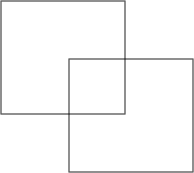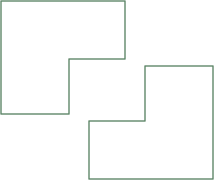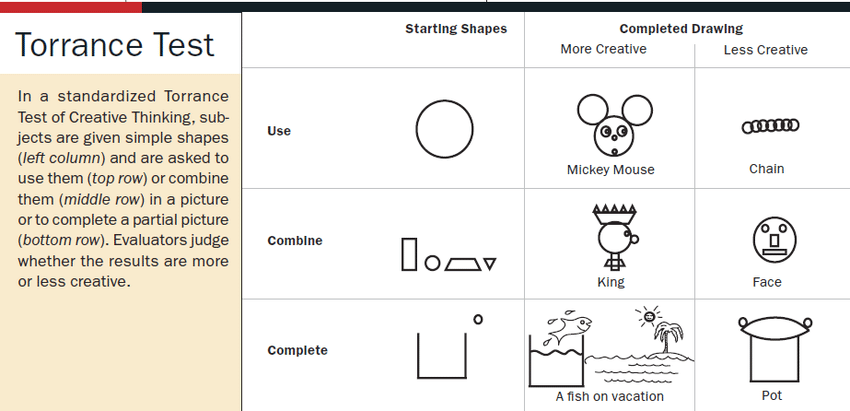Creative Thinking
Creativity Birthed in Creative Thinking
Creativity involves thinking that leads to original, practical, and meaningful solutions to problems or that generates new ideas or artistic expressions.
Creativity may be defined as originality of thought associated with the development of new, workable products or solutions to problems.
Thinking of a new product or a clever way of doing something are examples of creative thought when they lead to practical applications.
Creativity is not limited to a few geniuses in the arts or sciences. Psychologists recognize virtually all of us have the ability to be creative in our daily lives.
A parent who invents a new playtime activity for a four-year-old, a chef who combines ingredients in innovative ways, a worker who improves on a production method—all demonstrate creativity.
Highly intelligent people may perform efficiently and productively, though not necessarily creatively.Robert Sternberg (2001)
Figure X Two Interlocking Squares

|
| Figure X Two Interlocking Squares | Ponder this figure! Do you perceive two interlocking squares? Or might this figure represent something else? |
Figure X1 Two L-Shaped Figures

|
| Figure X1 Divergent Thinking | Compare Figure X (shown above) with the cutout shown here. Now imagine these two L-shaped figures pushed together so that they are separated by a square. |
Creativity is distinct from general intelligence (K.H. Kim, 2005; Nettelbeck & Wilson, 2005). Although most creative people have at least average intelligence, people at the higher echelon of intelligence are not necessarily any more creative than those of average intelligence. As psychologists Robert Sternberg (2001) notes, highly intelligent people may perform efficiently and productively, though not necessarily creatively.
Creativity is measured in different ways but most commonly through tests that tap divergent thinking. Divergent thinking is the wellspring of invention; it is the ability to conceive of new ways of viewing situations and new uses of familiar objects. By contrast, convergent thinking is the attempt to find the one correct answer to a problem. Refer back to Figure X. The answer (two interlocking squares) seems so obvious we may not think of any alternatives.
Yet by thinking divergently we can find other answers: three squares (note the one in the area of intersection), two L-shaped pieces separated by a square (see Figure X1), and a rectangle divided into two pieces that have been pushed askew.
Tests that tap divergent thinking were originated by psychologist J.P. Guilford and his colleagues. One widely used measure, the Alternate Uses Test, instructs subjects to list as many possible uses as they can for a common object, such as newspaper (Guilford et al., 1978). The person’s score is based on the number of acceptable responses the person is able to generate.
Figure X2 shows another way of measuring creative thinking, which is based on judging the creativity of a person’s drawings. When we think creatively, we use cognitive processes to manipulate or act on stored knowledge.
Figure X2 Torrance Test of Creative Thinking

|
| Figure X2 Torrance Test of Creative Thinking | In the Torrance Test, subjects are given starting shapes (left column) and instructed to create a new drawing by using them (top row), combining them (middle row), or completing them (bottom row). Evaluators then judge the creativity of the completed drawings. Source: Courtesy of ResearchGate Opens in new window |
Investigators identify a number of cognitive processes that underlie creative thinking, including the use of metaphor and analogy, conceptual combination, and conceptual expansion (Ward, 2004, 2007; Ward, Smith, & Vaid, 1997/2001).
- Metaphor and Analogy
Metaphor and analogy are creative products in their own right; they are also devices we use to generate creative solutions to puzzling problems. A metaphor Opens in new window is a figure of speech Opens in new window for likening one object or concept to another. Applying a metaphor involves a creative process of thinking of one thing as if it were another. For example, we might describe love as a candle burning brightly.
Analogy, of course, is a comparison between two things based on their similar features of properties—for example, likening the actions of the heart to those of a pump. As we noted, Alexander Graham Bell showed creative use of analogy Opens in new window in his invention of the telephone.
- Conceptual Combination
Cognitive psychologists believe combining two or more concepts into one can result in a novel ideas or applications that reflect more than the sum of the parts (Costello & Keane, 2001). Example of conceptual combinations include “cell phone,” “veggie burger,” and “home page.” Can you think of other ways in which concept can be creatively combined?
- Conceptual Expansion
One way of developing novel ideas is to expand familiar concepts Opens in new window. Examples of conceptual expansion include an architect’s adaptation of an existing building to a new use, a writer’s creation of new scenes using familiar characters, and a chef’s variation on a traditional dish that results in a new culinary sensation.
Creativity typically springs from the expansion or modification of familiar categories or concepts. The ability to take what we know and modify and expand on it is one of the basic processes of creative thinking.
related literatures:
- Jeffrey S. Nevid, Psychology: Concepts and Applications. (p. 260-1) Creativity: Not Just for the Few

